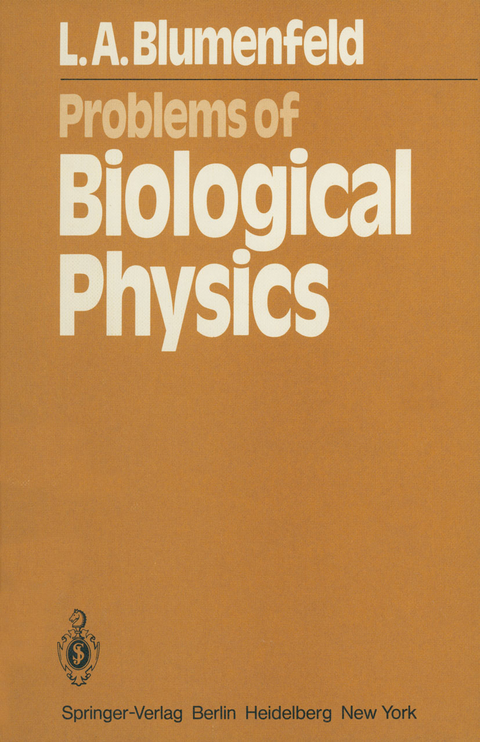
Problems of Biological Physics
Springer Berlin (Verlag)
978-3-642-67853-0 (ISBN)
Hermann Haken is Professor of the Institute for Theoretical Physics at the University of Stuttgart. He is known as the founder of synergetics. His research has been in nonlinear optics (in particular laser physics), solid state physics, statistical physics, and group theory. After the implementation of the first laser in 1960, Professor Haken developed his institute to an international center for laser theory. The interpretation of the laser principles as self organization of non equilibrium systems paved the way to the development of synergetics, of which Haken is recognized as the founder. Hermann Haken has been visiting professor or guest scientist in England, France, Japan, USA, Russia, and China. He is the author of some 23 textbooks and monographs that cover an impressive number of topics from laser physics to synergetics, and editor of a book series in synergetics. For his pathbreaking work and his influence on academic research, he has been awarded many-times. Among others, he is member of the Order "Pour le merite" and received the Max Planck Medal in 1990.
1. Introduction.- 1.1 What is Biophysics?.- 1.2 Cell Components and Their Specific Features.- 1.3 The Aim of the Book.- 2. The Ordering of Biological Structures.- 2.1 Are They so Ordered in Reality?.- 2.2 Entropy and Information.- 2.3 What is the Cost of Biological Ordering?.- 2.4 The Meaning of Biological Ordering.- 2.5 The Necessity of Mechanical Details.- 2.6 The Problems.- 3. Nonequilibrium Thermodynamics and Biological Physics.- 3.1 Open Systems.- 3.2 Phenomenological Relations.- 3.3 Stationary States.- 3.4 Dissipative Structures.- 3.5 Oscillatory Phenomena in Chemistry and Biochemistry.- 3.6 The Problems.- 4. On the Statistical Physics of Biopolymers.- 4.1 Where does Mechanics Begin?.- 4.2 Statistical Physics of a Linear Homopolymer.- 4.3 On the Statistical Nonequilibrium of Biopolymer Structures at Different Levels of Organi zation.- 4.4 On Certain Properties of Biopolymer Structures that Can Be Understood in Terms of Their Statistical-Physical Description.- 5. Conformational and Configurational Changes of Biopolymers.- 5.1 Introductory Remarks.- 5.2 Biopolymer Denaturation.- 5.3 On the Difference Between Activation Energy and Activation Enthalpy.- 5.4 Some Protein Reactions.- 5.5 On the Compensation Effect.- 5.6 On the Validity of the Van't Hoff and Arrhenius Equations and of the Activated State Theory for Biopolymer Reactions.- 5.7 On Spontaneous Conformational Oscillations of Protein Macromolecules.- 5.8 Conclusions.- 6. The Physics of Enzyme Catalysis.- 6.1 Background.- 6.2 Existing Interpretations of Enzymatic Activity.- 6.3 Conformational Changes as Necessary Steps of Enzymatic Processes.- 6.4 The Effect of Temperature on Enzymes and on the Activation Parameters of Enzyme Reactions.- 6.5 The Physics of Elementary Steps of Enzyme Catalysis [6.69,72,79,80].- 6.6 Dynamic Model for Aspartate-Amino-Transferase.- 6.7 Conclusions.- 7. The Physics of Electron Transfer in Biological Systems.- 7.1 Overview.- 7.2 Free Radicals and Radical Ions in Biochemical Reactions.- 7.3 Electron Transport Chains (ETC) in Mitochondrial and Chloroplast Membranes.- 7.4 Electron Transfer Reactions and Semiconduction in Biological Systems.- 7.5 On the Tunnelling Mechanisms of Electron Transfer Between the ETC Components.- 8. The Physics of Intracellular Energy Transformation and Accumulation.- 8.1 Overview.- 8.2 The ATP Problem.- 8.3 Substrate Phosphorylation.- 8.4 Membrane Phosphorylation: Thermodynamic Aspects.- 8.5 Membrane Phosphorylation: Existing Theories.- 8.6 Some Physical Aspects of Intracellular Energy Transformation as a Relaxation Process.- 9. Conclusion.- References.
| Erscheint lt. Verlag | 16.12.2011 |
|---|---|
| Reihe/Serie | Springer Series in Synergetics |
| Zusatzinfo | IX, 224 p. |
| Verlagsort | Berlin |
| Sprache | englisch |
| Maße | 170 x 244 mm |
| Gewicht | 421 g |
| Themenwelt | Naturwissenschaften ► Chemie ► Physikalische Chemie |
| Naturwissenschaften ► Physik / Astronomie ► Allgemeines / Lexika | |
| Naturwissenschaften ► Physik / Astronomie ► Angewandte Physik | |
| Naturwissenschaften ► Physik / Astronomie ► Theoretische Physik | |
| Schlagworte | Biophysik |
| ISBN-10 | 3-642-67853-X / 364267853X |
| ISBN-13 | 978-3-642-67853-0 / 9783642678530 |
| Zustand | Neuware |
| Haben Sie eine Frage zum Produkt? |
aus dem Bereich


